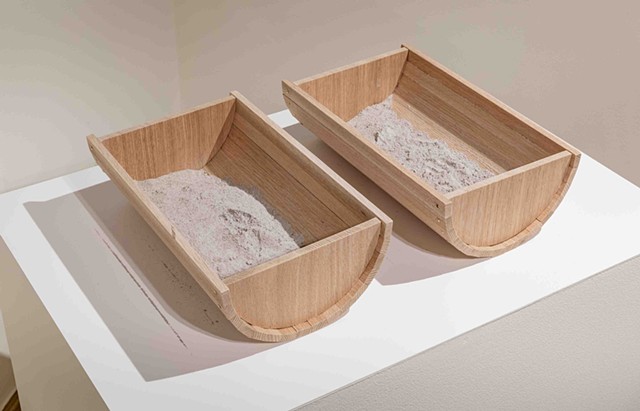- Strain series
This is an installation view from the exhibition I continue to shape curated by cheyanne turions at Justina Barnicke Gallery at the University of Toronto.
My interest in porous materials led me into the direction of creating these wooden sculptures in the summer of 2018.
These vessels Strainer #1 and #2 are made from quarter-sawn oak, as I wanted to use wood that is used in boat building to create these vessels. Although built so the wood fits quite tightly, this vessel is not watertight and therefore acts as a strainer letting through liquid and smaller particles, to make it watertight it would need to soak in water. This physical response to water means the wood needs the water to eventually resist water. To hold water or to be buoyant in water this vessel needs to absorb and swell.
To highlight its permeability, I exhibited with work filled with ashes from my wood stove. Hardwood ashes resulting from the winter months of heating my house. The ashes convey the dryness of the state of this wood and I installed this work with marks created by the straining ashes, lines on plinth's display surface emphasize further how open these vessels are in this state. Ashes strain through these wooded sculptures.
Their form is similar to half barrels, or even remind me of small cradles, the latter I only noticed much after I made them. I was thinking a lot about boat and barrel making when I was working on this work, I was also thinking about a story my mother told me about going to school on a boat when she was little. Where I live in Port Severn, the former owner of our house Houston King use to drive the school boat for kids living on the islands, I'm pretty sure that this is a different school boat than the one my mother rode in but still wish I knew more.
Soon after I made these two vessels I found an image in a book at the Textile Museum of Canada's library of a canoe baler made by an Anishinaabe man. The dimensions were not clear to me, but it had a shape similar to these vessels with the addition of handle that ran end to end. I'm interested to look at that image more and think through its use, and its design.
